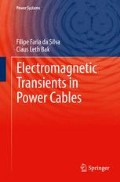Abstract
“Components Description”, describes several layers of a cable as well as their function. It also shows how to calculate the different electric parameters of a cable, resistance, inductance, capacitance, and how to use those values to calculate the positive-sequence and zero-sequence, including how to adapt the datasheet values for more accurate calculations. The chapter introduces the different bonding configurations typically used for the screens of cables (both-ends bonding and cross-boding) and also presents methods that can be used to estimate the maximum current of a cable for different types of soils, i.e. thermal calculations. The end of the chapter introduces the shunt reactor, which is an important element in cable-based network as it consumes locally the reactive power generated by the cables.
Access this chapter
Tax calculation will be finalised at checkout
Purchases are for personal use only
Notes
- 1.
The table shows only some of the values, for the full table consult the standard [11]. The values presented are for the future issue of the standard, which is not yet approved. Thus, the final version may have slightly different values.
- 2.
0.001 for a HV XLPE-type cable.
- 3.
Assuming transmission voltage levels.
- 4.
The semi-conductive layers are considered in the insulation for effects of calculation.
- 5.
For consistency, the notation used for some of the variables is slightly different from the one used in the standard.
- 6.
If the cables have different loads the value of T4 is calculated for each cable individually are the temperature calculation is changed (please refer to the standard [12] for this case).
- 7.
At the end of this chapter it is proposed an exercise for the calculation of the equation for a line with losses. The solution is available online, together with some plots showing possible scenarios.
- 8.
Because of the interaction between the shunt reactor and the cable during the transient (more on Chap. 4).
References and Further Reading
Moore GF (2007) Electric cables handbook, 3rd edn. Blackwell Science, Oxford
Benato R, Paolucci A (2010) EHV AC undergrounding electric power. Springer, London
Peschke E, von Olshausen R (1999) Cable systems for high and extra-high voltage—development, manufacture, testing, installation and operation of cables and their accessories. Publicis MCD Werbeagentur GmbH, Munich
Popović Zoya, Popović BD (2000) Introductory electromagnetic. Prentice Hall, New Jersey
Anders GJ (1997) Rating of electric power cables. IEEE press power engineering series, New York
Tziouvaras DA (2006) Protection of high-voltage AC cables, 59th annual conference for protective relay engineers
Cigre WG C4.502 (2013) Power system technical performance issues related to the application of long HVAC cables, CIGRE, Paris
Cigre WG B1.30 (2013) Cable systems electrical characteristics, Cigre, Paris
Cigre WG B1.19 (2004) General guidelines for the integration of a new underground cable system in the networks, Cigre, Paris
IEEE Standard C57.21 (1990) IEEE standard requirements, terminology, and test code for shunt reactors rated over 500 kVA, IEEE, New York
EC Standard 60287-1-1 (2006) Electric cables—calculation of the current rating—Part 1-1: Current rating equations (100 % load factor) and calculation of losses—general, IEC, Geneva
IEC Standard 60287-2-1 (2006) Electric cables—Calculation of the current rating—Part 2-1: Thermal resistance—calculation of thermal resistance—general, IEC, Geneva
Author information
Authors and Affiliations
Corresponding author
Rights and permissions
Copyright information
© 2013 Springer-Verlag London
About this chapter
Cite this chapter
da Silva, F.F., Bak, C.L. (2013). Components Description. In: Electromagnetic Transients in Power Cables. Power Systems. Springer, London. https://doi.org/10.1007/978-1-4471-5236-1_1
Download citation
DOI: https://doi.org/10.1007/978-1-4471-5236-1_1
Published:
Publisher Name: Springer, London
Print ISBN: 978-1-4471-5235-4
Online ISBN: 978-1-4471-5236-1
eBook Packages: EnergyEnergy (R0)

